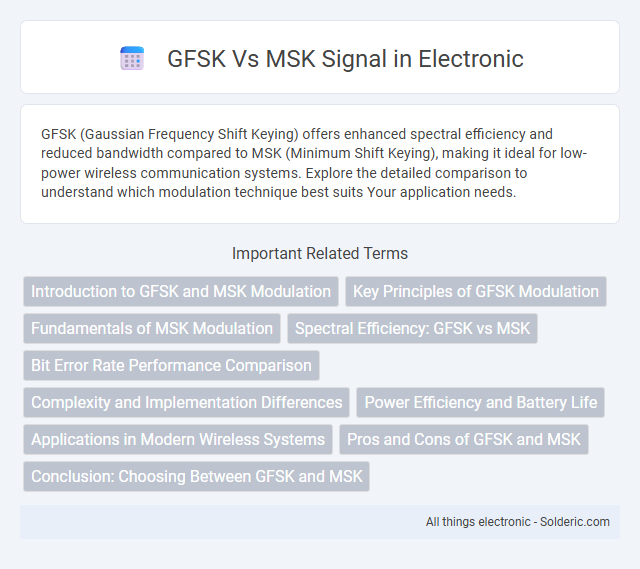GFSK (Gaussian Frequency Shift Keying) offers enhanced spectral efficiency and reduced bandwidth compared to MSK (Minimum Shift Keying), making it ideal for low-power wireless communication systems. Explore the detailed comparison to understand which modulation technique best suits Your application needs.
Comparison Table
| Feature | GFSK (Gaussian Frequency Shift Keying) | MSK (Minimum Shift Keying) |
|---|---|---|
| Modulation Type | Continuous-phase frequency modulation with Gaussian filter | Continuous-phase frequency modulation with minimal frequency shift |
| Bandwidth Efficiency | Higher due to Gaussian filtering | Moderate; bandwidth is twice the bit rate |
| Spectrum Characteristics | Narrower spectrum, smooth transitions | Constant envelope, spectral sidelobes reduced |
| Signal Phase | Continuous phase, smoothed by Gaussian filter | Continuous phase, phase difference of +-p/2 |
| Complexity | Low complexity, easy to implement | Moderate complexity, requires coherent detection |
| Bit Error Rate (BER) | Higher BER under AWGN compared to MSK | Lower BER performance under AWGN |
| Applications | Bluetooth, low power wireless | Satellite communication, cellular systems |
| Power Efficiency | Good due to constant envelope | High power efficiency, constant envelope |
Introduction to GFSK and MSK Modulation
Gaussian Frequency Shift Keying (GFSK) is a continuous-phase frequency modulation technique where data is encoded by shifting the carrier frequency between distinct frequencies, with a Gaussian filter applied to reduce bandwidth and intersymbol interference. Minimum Shift Keying (MSK) is a special case of continuous-phase frequency shift keying that maintains constant envelope and minimal frequency spacing, resulting in efficient spectral usage and reduced signal distortion. Both modulation schemes are widely used in wireless communication systems for their robustness against noise and spectral efficiency, with GFSK favored in Bluetooth technology and MSK in high-speed data transmission applications.
Key Principles of GFSK Modulation
GFSK (Gaussian Frequency Shift Keying) modulation shapes the digital data signal with a Gaussian filter before frequency modulation, reducing bandwidth and minimizing intersymbol interference. This filtering smooths frequency transitions, resulting in a continuous phase signal that enhances spectral efficiency compared to traditional FSK. Your communication system benefits from improved noise immunity and reduced adjacent channel interference, making GFSK ideal for wireless applications like Bluetooth and GSM.
Fundamentals of MSK Modulation
MSK (Minimum Shift Keying) modulation is a type of continuous-phase frequency shift keying that maintains a constant envelope and ensures phase continuity, minimizing spectral sidebands and reducing interference. It uses a frequency separation equal to half the bit rate, resulting in orthogonal signals that improve bandwidth efficiency compared to traditional FSK schemes like GFSK. Your communication system benefits from MSK's lower bit error rate and spectral compactness, making it ideal for wireless applications demanding high performance and robustness.
Spectral Efficiency: GFSK vs MSK
MSK (Minimum Shift Keying) exhibits higher spectral efficiency than GFSK (Gaussian Frequency Shift Keying) due to its continuous phase modulation and constant envelope, which minimize bandwidth usage and intersymbol interference. GFSK applies a Gaussian filter to smooth frequency transitions, reducing sideband power but increasing the occupied bandwidth compared to MSK. Consequently, MSK achieves superior bandwidth efficiency, making it preferable for systems requiring high data rates within narrow spectral allocations.
Bit Error Rate Performance Comparison
GFSK (Gaussian Frequency Shift Keying) and MSK (Minimum Shift Keying) signals differ notably in bit error rate (BER) performance under similar noise conditions. MSK typically exhibits superior BER performance due to its constant envelope and continuous phase nature, which minimizes bandwidth and intersymbol interference, making it more resistant to noise and fading. Your choice between GFSK and MSK should consider the trade-off between spectral efficiency and error resilience depending on the communication system requirements.
Complexity and Implementation Differences
GFSK (Gaussian Frequency Shift Keying) offers lower complexity with simpler modulation and demodulation processes compared to MSK (Minimum Shift Keying), making it more suitable for resource-constrained devices. MSK provides optimal spectral efficiency and reduced phase discontinuities but requires more sophisticated signal processing and precise synchronization, increasing implementation complexity. Your choice between GFSK and MSK should consider the trade-off between system complexity and performance demands.
Power Efficiency and Battery Life
GFSK (Gaussian Frequency Shift Keying) offers improved power efficiency due to its reduced spectral bandwidth and lower sideband power, which minimizes interference and energy consumption in wireless transmitters. MSK (Minimum Shift Keying) provides constant envelope modulation, allowing power amplifiers to operate at maximum efficiency with less distortion, thereby extending battery life in portable devices. Selecting MSK often results in better battery performance in systems requiring robust, energy-efficient communication over longer durations.
Applications in Modern Wireless Systems
GFSK (Gaussian Frequency Shift Keying) and MSK (Minimum Shift Keying) are widely used in modern wireless systems for their spectral efficiency and resilience to noise. GFSK is commonly employed in Bluetooth and GSM technologies due to its reduced bandwidth and low power consumption, optimizing battery-operated devices. MSK, with its constant envelope and minimal phase discontinuities, is favored in satellite communications and military radios where signal robustness and interference resistance are critical.
Pros and Cons of GFSK and MSK
GFSK (Gaussian Frequency Shift Keying) offers spectral efficiency and reduced bandwidth due to Gaussian filtering, making it ideal for wireless communications with limited spectrum, though it suffers from lower power efficiency and higher error rates in noisy environments. MSK (Minimum Shift Keying) provides constant envelope signals with minimal phase discontinuities, resulting in better power efficiency and robustness against phase noise, but its bandwidth is slightly larger than GFSK, which can limit spectral efficiency. Choosing between GFSK and MSK hinges on application requirements such as bandwidth constraints, power efficiency, and noise tolerance.
Conclusion: Choosing Between GFSK and MSK
GFSK offers advantages in power efficiency and spectral compactness, making it ideal for low-power wireless applications such as Bluetooth and Zigbee. MSK provides better constant envelope properties and reduced intersymbol interference, suitable for high-speed data transmission in mobile communications. Selecting between GFSK and MSK depends on system requirements like bandwidth constraints, power consumption, and data rate demands.
GFSK vs MSK signal Infographic

 solderic.com
solderic.com